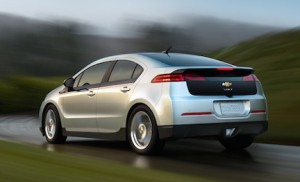Jon Lauckner, President GM Ventures, said that GM now has a straightforward vision, “Design, build and sell the world’s best vehicles.” I took notes as he gave his keynote speech at the Clean Tech Investors Conference and asked him about GM’s investment priorities. To achieve GM’s vision, focus is now placed on four strategies: (1) a culture that is more aggressive and flexible, (2) customer focus, (3) Team GM, and (4) technology.
Mr. Lauckner is focused on investing in innovative and early stage companies. He has been busy since GM Ventures was established last June and he was promoted from head of GM global product planning. GM Ventures has invested in Bright Automotive, which has designed an advanced plug-in hybrid delivery van with much greater cargo space than Ford’s Transit Connect Electric. GM has invested in two advanced next generation biofuel corporations – Mascoma and Coskata. Given the success of the Amyris IPO, these investments could should a high return for GM.
Although GM has the potential to drive down lithium battery cost and weight with its strategic partner LG Chem, supplier for the Volt. The two corporations recently licensed cathode technology from Argonne National Lab that can lead to better energy density and make future cars like the Chevrolet Volt even more cost effective.
GM is also looking beyond today’s lithium technology. GM Ventures has invested in SAKTI3, which has developed a rechargeable solid-state battery with the potential to lower the cost of manufacturing batteries.
All of these innovators are creating offerings that could accelerate GM offering a wider range of vehicles, lower the carbon footprint of GM vehicles, and make electric cars less expensive than gasoline powered in this decade. So far, all of these innovators are U.S. based and already creating hundreds of new jobs. GM is open to investing globally and often partners with venture capitalists such as Khosla Ventures, corporate private equity such as Itochu Technology Ventures, and public economic development such as the Michigan Economic Development Corporation.
The technology will not necessarily become a GM offering, but that is a potential value-added in partnering with GM Ventures. For example, Powermat is not only receiving a $5 million investment from GM Ventures, Powermat will be offered in many 2012 GM cars. Powermat solves that problem of trying to keep many mobile electronic devices charged. Forget using the cigarette lighter. Powermat’s technology allows electronic devices – smart phones, MP3 players and gaming devices – to be charged inductively by just placing them on the Powermat.
What will be the next General Motors investment? Speaking to over 400 executives at the Clean-Tech Investor Summit, co-produced by International Business Forum and Clean Edge, Jon Lauckner said that GM Ventures is looking for promising innovation in these areas:
Automotive Cleantech
- EV
- Fuel cell
- Charging
- Emission controls
- Motors
- Smart grid
- Energy efficiency for vehicles
- Biofuels
Infotainment
- Vehicle HMI
- Voice recognition technologies
- In-vehicle advertising
- Cloud services
- Personal device integration
Smart Materials
- Cost
- Mass
- Lightweight materials
- Eco-friendly materials
Automotive-Related Technologies
- Innovations for unmet consumer needs
- Advanced sensors for autonomous driving
- Safety features
Value Chain / Business Model
- New automotive business models
- Leverage GM technology and assets for upstream and downstream revenue
I asked Jon Lauckner about alternatives to rare earth elements. Currently, the motors in electric cars and hybrids are permanent magnet motors. To improve weight, efficiency and heat resistance, rare earth elements such as neodymium and dysprosium are used in these permanent magnets. Such rare earths are currently mined in China, but the big money is not in the mining, it is in the final products. China is restricting rare earth exports, and giving priority to using rare earths in its own manufacturing of turbines and motors for products ranging from military systems to high-speed rail to electric cars.
Toyota Motors is developing inductive car motors that do not use rare earths. Although Lauckner was carefully non-committal about whether GM is also working on inductive automotive electric motors, he did say that he would be “very interested” in such motors requiring no rare earths. Smart materials, nanotechnology, and advanced powertrain components are all strategic to the future of GM.
In one decade, transportation will be very different from today. With GM Ventures, General Motors is positioned to invest, integrate, and deliver to global customers better cars and services that include innovations in cleantech, infotainment, materials, autonomous driving, and new business models.


Thanks GM. Too badf it took you 20 years to realize that solar recharging of your batteries was possible.
Could one of your genious engineers come up with a swappable battery?
Sell it worldwide. The sun is your friend. Oil (and oil terrist money) is your enemy.